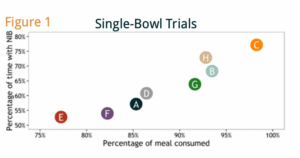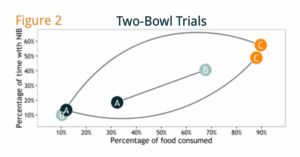OVERVIEW Palatants are flavor enhancers used in pet foods to improve their palatability and increase pet acceptance. Developing an effective palatant involves a systematic approach to selecting the best combination of ingredients that provide the optimal aroma and taste for cats and dogs. However, some ingredients have inherent natural variability...

Taste Test Methodology – Nose In Bowl
How can you tell if your dog enjoys her new food? At AFB International, we develop new tasty flavors for dog enjoyment. We also pioneer new ways to interpret dogs’ feeding behavior to tell us about meal enjoyment in addition to how much they ate. One such behavior metric is determined by NOSE IN BOWLSM taste test methodology, a test method available only from AFB International, Inc. NOSE IN BOWLSM test is the amount of time a dog spends eating relative to the amount of time her food is available. It gauges the dog’s focus on the food. Even if your dog eats all of what you give her, is the food enjoyable enough for her to be “nose in bowl” most of the time?
In two-bowl feeding trials, preference is easy to measure; dogs eat more of the food they prefer. However, in a single-bowl trial, which is desirable because it closely mimics in-home feeding, most dogs will finish all of the food. The NOSE IN BOWLSM test metric indicates the level of interest in the food, despite an empty bowl every time.
AFB conducted a 20-day single-bowl trial with 18 mid- sized dogs (ages 2 to 12), where a total of eight dry foods were repeatedly offered using a randomized block design. During the daily trials, foods were offered for a maximum of 20 minutes to each dog. The food types offered, products A – H , were either off-the-shelf dry foods or new AFB formulations. During feedings, we recorded the durations that dogs spent eating relative to time spent doing anything else, such as resting or drinking.
Figure 1 shows the results of the single-bowl trials. Food C was consumed most and also had the highest NOSE IN BOWLSM test, while food E was consumed least and had the lowest NOSE IN BOWLSM test. On average, dogs ate 98% of food C and, for 77% of the time the food was available, they were focused on eating. In contrast, dogs ate only 77% of food E on average and were focused on eating only 53% of the time the food was in front of them. Diets E and F resulted in dogs being most distracted by other events relative to Diet C.

NOSE IN BOWLSM test is more interesting when foods perform similarly for amount consumed, as with G, B and H. Average consumption was 92% to 94% for all, but H had the highest NOSE IN BOWLSM test value. Even though these were consumed nearly equally, dogs were more focused on eating when offered H than when offered B or G .
NOSE IN BOWLSM test also provides richer information on dog enjoyment when added to a two-bowl paired preference feeding trial. Figure 2 shows results of two- bowl trials, each offered over two consecutive days (six days total). The gray lines connect paired foods offered. Preference ranking for the three foods was similar to the single-bowl trials; C was consumed most and had the highest NOSE IN BOWLSM test, while A was consumed least and had the lowest NOSE IN BOWLSM test. When food C was an option, dogs were occupied with eating C an average of 53% of the time, compared to just 16% for A and 25% for B.
In addition to NOSE IN BOWLSM test, behaviors such as number of visits to the bowl during a feeding session and number of
To learn more about our high-performing palatant systems, contact your sales representative or visit https://www.afbinternational.com/contact/